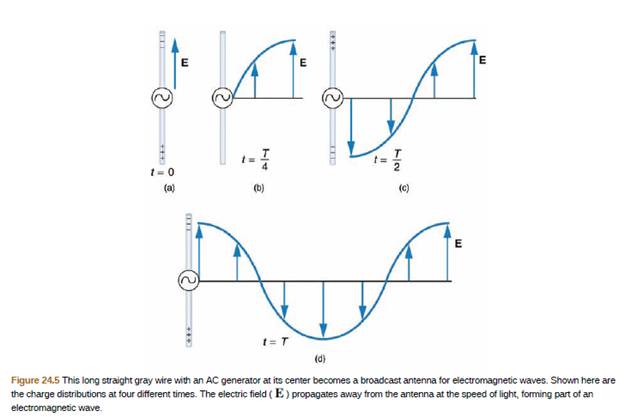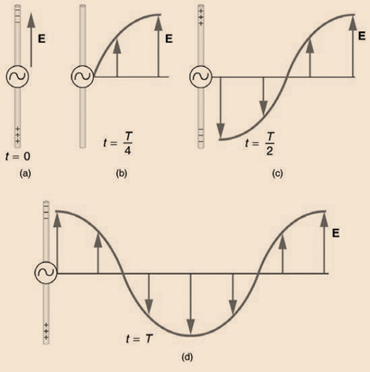
Concept explainers
The direction of the electric field shown in each part of Figure 24.5 is that produced by the charge distribution in the wire. Justify the direction shown in each part, using the Coulomb force law and the definition of E = F/q, where q is a positive test charge.

The direction of the electric field shown in each part of Figure is that produced by the charge distribution in the wire.
Answer to Problem 1CQ
- The direction of the electric field is upward
- The value of electric field is zero.
- The direction of the electric field is downward
- The direction of the electric field is upward
Given info:
Justify the direction shown in each part, using the Coulomb force law and the definition of E=F/q, where q is a positive test charge?

Explanation:
Positive charge moves from positive to negative, so the direction of electric field in part a is towards upper direction.
The distances between the positive and negative charge in part b is zero, so the electric field value is zero, so there is direction.
Positive charge moves from positive to negative, so the direction of electric field in part c is towards downward direction.
Positive charge moves from positive to negative, so the direction of electric field in part a is towards upper direction.
Conclusion:
The direction of the electric field shown in each part of Figure is studied.
Explanation of Solution
Given info:
Justify the direction shown in each part, using the Coulomb force law and the definition of E=F/q, where q is a positive test charge?

Positive charge moves from positive to negative, so the direction of electric field in part a is towards upper direction.
The distances between the positive and negative charge in part b is zero, so the electric field value is zero, so there is direction.
Positive charge moves from positive to negative, so the direction of electric field in part c is towards downward direction.
Positive charge moves from positive to negative, so the direction of electric field in part a is towards upper direction.
Conclusion:
The direction of the electric field shown in each part of Figure is studied.
Want to see more full solutions like this?
Chapter 24 Solutions
College Physics
Additional Science Textbook Solutions
University Physics Volume 2
College Physics (10th Edition)
Sears And Zemansky's University Physics With Modern Physics
Conceptual Physics (12th Edition)
College Physics: A Strategic Approach (3rd Edition)
- An electron moving with a velocity v=(4.0i+3.0j+2.0k)106m/s enters a region where there is a uniform electric field and a uniform magnetic field. The magnetic field is given by v=(1.0i2.0j+4.0k)102T. If the electron travels through a region without being deflected, what is the electric field?arrow_forwardIn a region of space, a magnetic field is uniform over space but increases at a constant rate. This changing magnetic field induces an electric field that (a) increases in time, (b) is conservative, (c) is in the direction of the magnetic field, or (d) has a constant magnitude.arrow_forwardIn the figure below, an electron moves at speed v = 100 m/s along an x axis through uniform electric and magnetic fields. The magnetic field is directed into the page and has magnitude 5 T. Find the magnitude of the electric field Sketch the electric fields lines in the figure belowarrow_forward
- An electric current of 10A is flowing through a straight conductor. Calculate the intensity of magnetic field at a distance 10m from it.arrow_forwardIf I am asked to describe the direction of the magentic field for this image. Is it correct to say the magnetic field is coming out of the page?arrow_forwardA uniform electric field of magnitude 140 kV/m is directed upward in a region of space. A uniform magnetic field of magnitude 0.54 T perpendicular to the electric field also exists in this region. A beam of positively charged particles travels into the region. Determine the speed of the particles at which they will not be deflected by the crossed electric and magnetic fields. (Assume the beam of particles travels perpendicularly to both fields.) m/sarrow_forward
- If the electric field emitted by a radio tower has an amplitude of 174 V/m, what is the amplitude of the corresponding magnetic field?arrow_forwardfind the direction of the force if: a positive charge moving out of the screen in a magnetic field that points upward a positive charge moving downward in an electric field that points out of the sreen a negative charge moving to the right in a magnetic field that points to the leftarrow_forwardEnergy carried by light is related to its electromagnetic fields in which ways? Pick all that apply. MORE THAN ONE ANSWER is proportional to the product of the electric and magnetic fields is proportional to the square of the electric field is proportional to the amplitude of the electric field flows perpendicular to both the electric and the magnetic fields flows in the direction of the electric fieldarrow_forward
- Your friend just bought a magnetic field sensor and convinced you to help him measure the magnetic field at a certain distance from your local radio station's antenna. The maximum magnetic field that you measure is 1.96·10-11 T and a quick Google search tells you that this particular station broadcasts at a frequency of 778 kHz. What is the maximum electric field in V/m of the emitted electromagnetic waves?arrow_forwardThe speed of light, first experimentally measured to be about c=3×10^8m/s, can be expressed in terms of other fundamental constants relating to electricity and magnetism. Give this algebraic expression and briefly explain where it comes from.arrow_forwardPolarisation can be found in many sections of physics even in electrostatics. Examples of 'home-testable experiments' that shows charge polarisation include A. Rubbing a balloon against your hair to get it 'charged' up! B. Rubbing a plastic ruler with a woollen cloth. C. none of the given options are correct. D. Rubbing a glass rod with a silk cloth.arrow_forward
 Principles of Physics: A Calculus-Based TextPhysicsISBN:9781133104261Author:Raymond A. Serway, John W. JewettPublisher:Cengage Learning
Principles of Physics: A Calculus-Based TextPhysicsISBN:9781133104261Author:Raymond A. Serway, John W. JewettPublisher:Cengage Learning Physics for Scientists and Engineers, Technology ...PhysicsISBN:9781305116399Author:Raymond A. Serway, John W. JewettPublisher:Cengage Learning
Physics for Scientists and Engineers, Technology ...PhysicsISBN:9781305116399Author:Raymond A. Serway, John W. JewettPublisher:Cengage Learning


